This was published 2 years ago
From our greatest basketball export to US sporting pariah: Can Simmons bounce back?
Touted as a “once-in-a-generation talent”, Melbourne-born basketballer Ben Simmons moved to America, signed a $US170 million contract and even dated a Kardashian. Then he became one of the sport’s most loathed figures. What really went down?
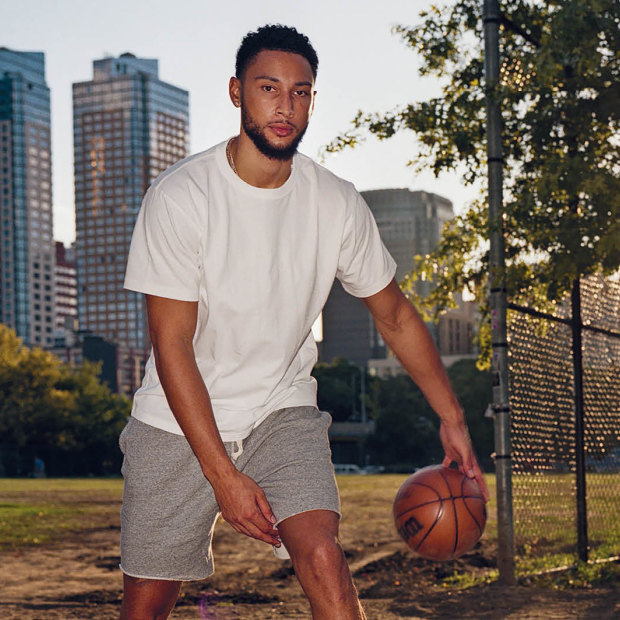
A losing play in a 2021 final made Ben Simmons the most hated player in US basketball. “Everyone’s been tearing me down for a year,” he says. “It sucks.”Credit: Ben Sklar
High on a red-brick building in Brooklyn, the considerable frame of Ben Simmons exits a private lift into a members-only New York City social club. Clad completely in black, he slides into the rooftop September sunshine like a wraith, 208 centimetres tall (6 foot 10 inches), looking languid yet swift, just as he does on the basketball court.
Bellying up to the terrace bar, he removes his sunglasses, takes a sip of a San Pellegrino and smiles. Any wonder. Staring down at the Brooklyn Bridge, the Statue of Liberty and the monoliths of lower Manhattan, the young National Basketball Association star from Melbourne whom they once called “The Wizard of Oz” can’t help but note – like Dorothy Gale in black Stussy kicks – that he’s not in Philadelphia any more.
“That’s a blue-collar city. Not too many surprises. Sports, work, Eagles, Sixers, Flyers – that’s Philly,” says Simmons, 26, who was traded away from that pit of parochialism at the start of the year to the Brooklyn Nets, a shift not without controversy. “I had a great time there. I didn’t mind living there … for a while. But I grew out of that.”
This is what’s known as an understatement. For those who don’t follow basketball, almost 500 days ago during an important final for the Philadelphia 76ers, Simmons performed a relatively benign yet objectively poor play, sparking a sad chain of events: the loss of the game being followed by public spats, trade stand-offs, long-term physical injury, longer-term mental-health issues, and now – finally – a stuttering comeback.
The ongoing “Ben Simmons Saga” turned into a sporting soap opera, covered in such unrelenting detail that the 2016 number-one draft pick, 2018 rookie of the year and 2019 recipient of a five-year, $US170 million contract – a three-time All-Star, and certainly the best NBA player Australia has ever produced – became the most loathed figure in basketball, if not the most maligned athlete in America.
Depending on the pundit you quote, Simmons is a punk or a star, cry-baby or victim, phenom or disgrace, stud or dud, beast or bust, bum or brat – fraud or faker or freak. He’s also become a kind of mental-health test case – alongside Naomi Osaka and Simone Biles and Nick Kyrgios – for how much attention and pressure and sheer spite athletes should be expected to endure.
“I had a terrible year,” Simmons says, flatly, “so I know how to handle my emotions and what I need to be doing to get on track. If I’m worried or sad or frustrated or angry, I feel like I’m better able to deal with that now. It took time, but I’m at peace with who I am and what’s going on around me. I know what my priorities are, and what I need to do every day. Besides that, I just want to be me.”
Consider for a moment what that’s like, just to be him. Somewhere behind the lopsided labels slapped on his persona – overrated, underrated, pathetic, persecuted – there’s a person trying to reconcile the difference between how much he’s worth and how much he’s paid, where he’s come from and where he’s going – all in full public view. This is the warped and dehumanising business of being Ben Simmons.
“I know I’m not gonna go out there and suck. I know that’s not going to happen. I would have to be a different person.”
“Everyone’s been tearing me down for a year straight,” he says, pausing. “It sucks.” But all that criticism is fuel, too, for a new season that’s now two weeks old but, when we met in September, had not yet begun. “I love when people are talking shit, wanting to see me down, because in my head I’m playing with house money. I know I’m not gonna go out there and suck. I know that’s not going to happen. I would have to be a different person.”
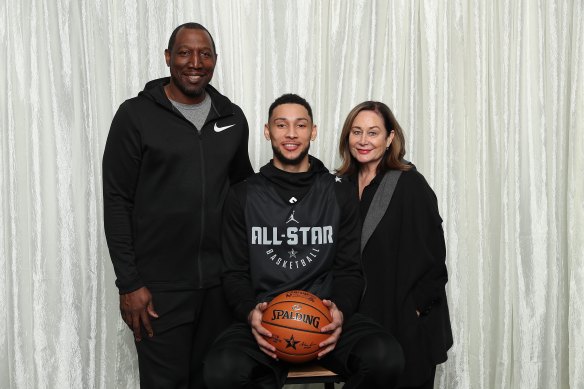
Simmons with his mum, Julie, and dad, Dave, a Bronx native and star of the Melbourne Tigers during Australian basketball’s 1990s heyday.Credit: Courtesy of Ben Simmons
To understand the captivating fall, you need to know the remarkable rise. Ben Simmons was the youngest of six children in a blended family, his mum Julie bringing four kids (Melissa, Emily, Liam and Sean) into her marriage to Bronx native Dave Simmons – an African-American star of the Melbourne Tigers during Australian basketball’s 1990s heyday – after which Olivia and Ben were born. Growing up in suburban Blackburn North, Ben Simmons was quiet, though not timid. He made friends easily. Knew right from wrong. Took up arms against bullies on behalf of others.
His talent for basketball was obvious and instinctual. “I can’t dance, so my dancing is done on the court. That’s my shit,” he says, nodding. “I love to win, I love to compete, but I love to be creative. That’s my art. When I’m on the court, I’m there to be who I am. I get to flow, make moves. I’ve always loved being entertaining on the floor, playing with some magic, using my IQ to have fun with the game, while winning. Winning and having fun – if I’m doing those two things, I’m good.”
And win he did, developing a potent mix of defensive menace, prolific passing and bewitching highlights. The gym at Box Hill Senior Secondary College was packed with students whenever he played, and by the end of year 9 he was dominating against year 12s. “This one time, boom, he came out and dropped, like, 30 points and 15 rebounds,” says his then coach Kevin Goorjian, the brother of Boomers coach Brian Goorjian. “The other team was asking for his autograph! They all wanted video of this game where they just got beat by a kid.”
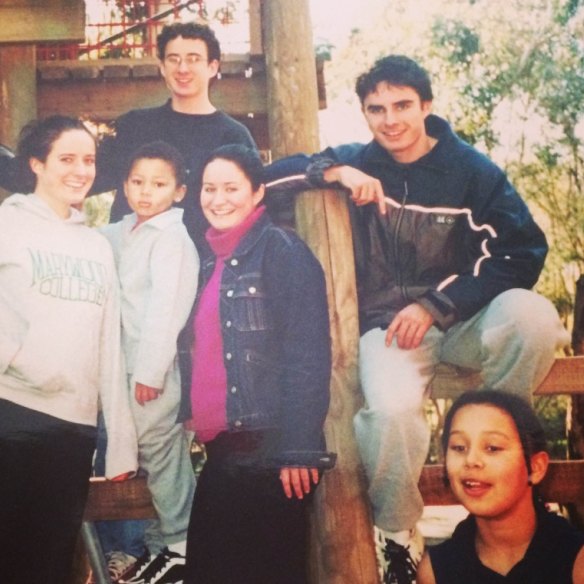
A young Ben with his brothers and sisters: top, Sean; middle, Emily, Ben, Melissa, Liam and Olivia.Credit: Courtesy of Ben Simmons
At the 2012 Pangos All-American Camp in California, a gathering of the top young players in the US and beyond, Simmons was 15 yet stole the show. Flooded with recruiting letters from American high schools, his mum was concerned. After all, he’d moved to the Australian Institute of Sport only a year earlier, and moved back home soon after. “He couldn’t stand being away in Canberra, let alone the other side of the world,” Julie says, from her Mornington Peninsula home. “But Ben came out to me in the backyard: ‘Mum, please don’t stop me. This is what I’ve gotta do. I’ve gotta go.’ ”
Go he did, to Montverde Academy, a basketball boot camp on the outskirts of Orlando. In the cafeteria there he met close mate Tahj Malone, both of them adjusting to the militaristic boarding school. “The school humbles you,” says Malone. “It doesn’t care about status. Lights out is lights out for everyone. It was a little tricky in the beginning for Ben.” He thrived, though, and by year 11 – following viral video “mix tapes” of his talents – Malone watched as his fêted friend was ordained as a future superstar. “And that attention – when you’re stuck in a dorm and can’t even go for a walk or leave campus – I think that was a struggle.”
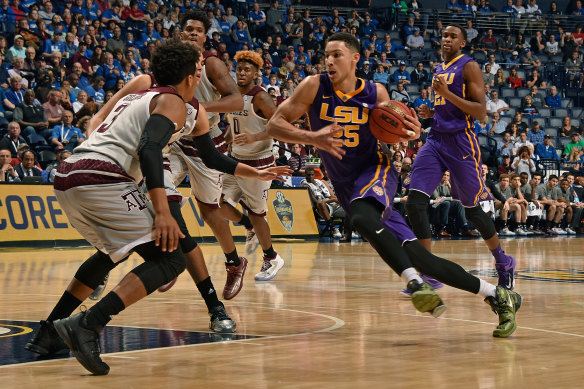
Simmons on court during his year at LSU. He was later benched by his coach for not attending classes.Credit: Getty Images
Turning his back on college basketball powerhouses, in 2015 Simmons chose to play at Louisiana State University, where his godfather coached. Alumnus Shaquille O’Neal pumped him up on Instagram: “LSU just signed the best player in the world. Check him out.” Magic Johnson chimed in, too: “Ben Simmons is the best all-round player I’ve seen since LeBron James came out of high school straight to the NBA!” (Even King James himself had a private word: “You have an opportunity to be better than me. But you can’t skip steps. You have to do the work.” ) The university raised a billboard with a photo of his torso and the tagline: “He’s coming.”
But he wasn’t exactly staying. At the time, NBA rules meant players could only be drafted if they were 19 and one year removed from high school, giving birth to the “one and done” phenomenon, also the title of a 2016 documentary about Simmons and his time at college, a speed bump on the road to his career. (As his mum notes in the film, if your child is a violin prodigy, no one says you have to go to university for a year before joining the philharmonic.) Nevertheless, the teacher of an LSU study-habits class complained that Simmons wasn’t attending lectures. Simmons was benched by his coach and his occasional “grade shaming” became national news. “The class wasn’t pointless, but for me it wasn’t necessary,” Simmons says now.
“And the school was making money off me. I don’t put my foot down a lot, but I did. I was tired. I was training constantly, and I had all these photo shoots they wanted me to do.”
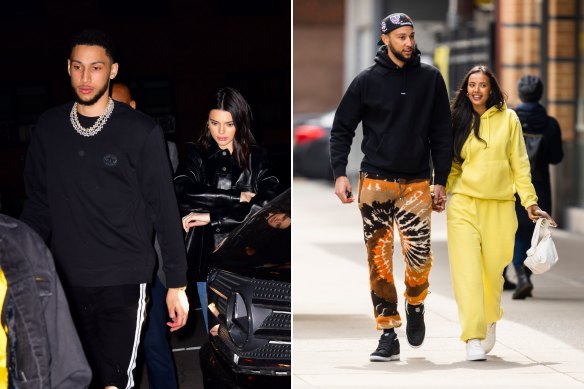
Simmons, left, with former girlfriend Kendall Jenner, and right, with now ex-fiancée Maya Jama.Credit: Getty Images
It’s hard to overstate the hype. Once Simmons declared for the draft, Foot Locker and Beats by Dre became sponsors, and he signed a five-year deal with Nike worth $US20 million (though not before hearing an Adidas pitch with a personal message from Snoop Dogg). He’s dated an Instagram model, a college basketballer, a singer-songwriter, a Kardashian (Kendall Jenner) and a TV presenter (Maya Jama). He’s currently single.
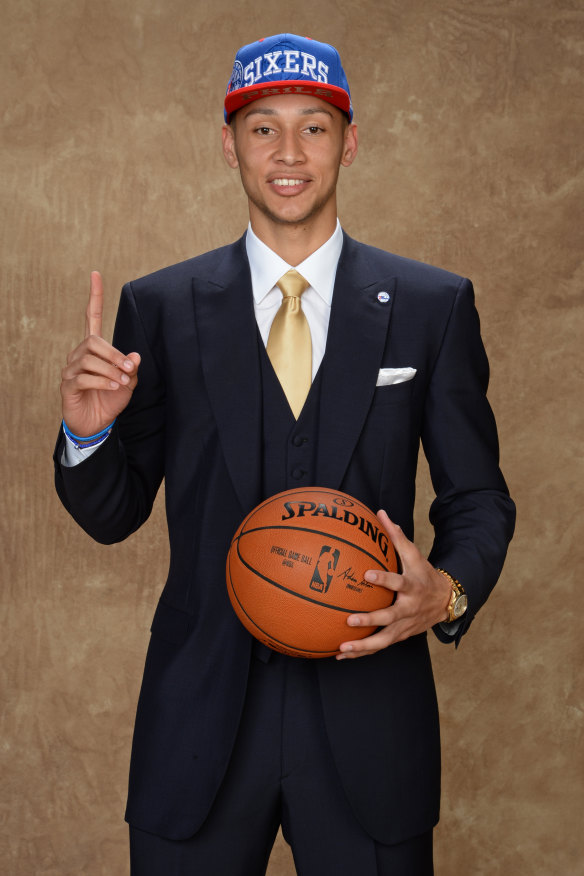
Simmons was the No. 1 draft pick in 2016, ultimately joining the Philadelphia 76ers.Credit: Getty Images
As the 2016 No.1 draft pick, the expectations were colossal, particularly in Philadelphia, where the 76ers were in the midst of an infamous long-term rebuilding plan, trading away stars and finding creative ways to lose to “earn” high draft picks. Patient fans were conditioned to “trust the process” – a rallying cry and slogan for tanking – and Simmons was their reward. “It was exciting,” says Keith Pompey, the 76ers beat writer for The Philadelphia Inquirer. “You’re looking at him, 6 foot 10 and extremely athletic, this guy we thought was a once-in-a-generation talent. The city was abuzz.”
Simmons was injured for his first year there, but once fit, he was an immediately explosive presence. “Running on the hardwood arenas, warming up, tip-off, all these different cities – it’s rare to be on that court,” he recalls. “You hear your name called out when you enter the arena. You dunk on somebody who you grew up watching. It’s incredible.”
One of his earliest lessons came courtesy of star forward Kawhi Leonard, whose 221-centimetre wingspan exemplified the kind of frightening physical attributes Simmons hadn’t considered. Leonard simply reached forward, arms like Inspector Gadget, and stole the ball from Simmons’ grasp. “You can’t go onto any NBA floor and cruise. You get exposed quickly,” Simmons says. “I was always able to think of a crazy idea in my head and then do it on court – then you get to the NBA and it’s a business, it’s a job, it’s a livelihood, and you gotta do what you do well. It gets serious.”
He racked up accolades as part of an ascendant team, which even partnered with Australia’s Four’N Twenty pies, hosting a popular Australian Heritage Night each year. Yet all the while, doubt and dissatisfaction were brewing over the one shortcoming in his arsenal: shooting. If that sounds a fundamental act for a player to master, that’s because it is. Yet Simmons’ ability to control the tempo of the game, pass, rebound and steal – in between dunks and lay-ups – bridged this gap in his skill-set.
Weaknesses can always be exploited, however, and teams found ways to blunt his stardom. By the start of the 2020-21 season, Philly fans were split – half resented him and half defended him. Rumours of a trade emerged. “I was already going to therapy,” Simmons says. “I got into a really dark place in my life. ‘Why do I feel like this? What’s happening to me?’ It was a build-up of everything – all that pressure, and multiple things going on with my family. I’m not sure if you’re aware of that?”
That’s a reference to his sister Olivia, with whom he was close growing up, and who in early 2021 accused their half-brother Sean Tribe of molesting her as a child. Her tweets on the subject were denied by the family and later found to be defamatory. “I was the target, so I felt a responsibility to keep everything together,” says 36-year-old Tribe, Simmons’s manager since his days in Louisiana until last year. “But that affects me, therefore it affects Ben, because we’re family and I’m working with him every day.”
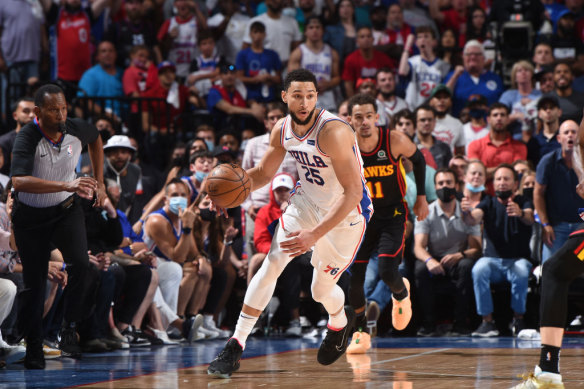
Simmons playing for the Philadelphia 76ers last year.Credit: Getty Images
With his professional and personal lives both shaken, Simmons was adrift. “These things just started piling up and piling up, and basketball was supposed to be my happy place, where I’m able to be free and express myself, and suddenly I wasn’t able to do that.” Before countless games he would call his sister Emily, who manages Simmons’s marketing and had, like Tribe, moved to the US to support him. He remembers once asking her a simple plaintive question: “Do you ever just wake up sad?”
Tribe says the rest of the season became an exercise in helping his brother navigate his emotions enough to stay focused. “It’s such a f…ed up thing to say, but you’re earning this amount, and the expectations reflect that, so you feel obliged to say, ‘I know you’re dealing with shit, but you have a responsibility,’ ” he says. “Winning pushes everything to the side, too. And they were winning.”
“You feel obliged to say, ‘I know you’re dealing with shit, but you have a responsibility.’ ”
Matters came to a head in a June 2021 final against the Atlanta Hawks, when Simmons, who was underperforming at the time, had an opportunity to dunk the ball – or be fouled – but instead passed. His critics howled that his shooting deficiency had made him a liability, frightened of taking free throws. He was branded a coward over a split-second decision. “If I could go back I would go up strong, go to the line,” Simmons says. “But there was so much emphasis on that moment. I made a bad play, but loads of guys made bad plays. I’m not the reason we didn’t win.”
If that was the beginning, the end came into focus when 76ers coach Doc Rivers was asked: “Can Ben Simmons be the point guard of a championship team?” and answered, “I don’t know the answer to that right now.” Or maybe it was when star teammate Joel Embiid appeared to blame the player for the loss. Simmons requested a trade, the 76ers refused, and a standoff began in which he refused to front up to training camp or media day that September.
“I definitely didn’t handle it the right way after the season, but there’s two sides,” he says. “Your teammates are supposed to have your back. Your coaches are supposed to have your back. And I didn’t have that at all.”
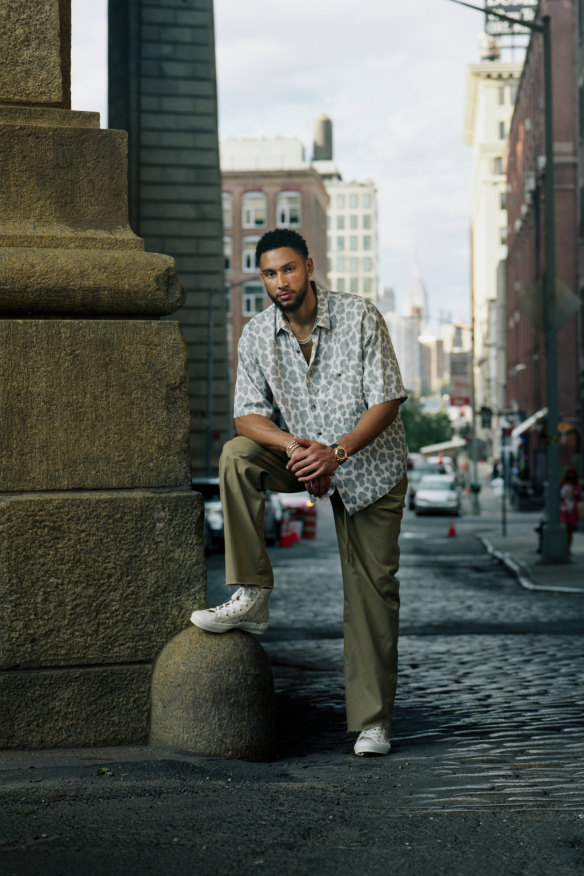
“Your teammates are supposed to have your back. Your coaches are supposed to have your back. And I didn’t have that at all,” says Simmons of his treatment by the Philadelphia 76ers.Credit: Ben Sklar
His mental-health issues – bound up in depression but also the trappings of fame and the pressure of the game – were dismissed or downplayed. The club was frustrated, too, that Simmons refused to allow its doctors to assess his mental readiness. It all spilled over one day when he was suspended for not taking part in a defensive drill. “I still wasn’t ready in my head. I wasn’t in a place to get on the court and play. I went to Coach and said, ‘I’m not ready yet to get back on the court, I need some time.’ He says, ‘Well, I’m going to put you out there regardless,’ ” Simmons says, shaking his head. “Okay, so now you’re just trying to f… with me.”
The team began docking his wages $US360,305 for every missed game, and placed $US8.25 million of his salary in escrow (in case they needed to keep fining him). Simmons’s pride arguably turned the whole affair into a game of chicken. “At the time it feels justified,” Tribe says, “but when you look back and reflect, you wonder if there was an opportunity to leave the door open. Maybe he could have come to training camp and started the season, but still asked for a trade?”
Simmons instead went silent. He says he felt stoic. Indeed, part of what seems to gall his critics is a trademark lack of overt expression – call it resting blank face. But don’t mistake his inscrutability for obliviousness. Schoolmate Tahj Malone was living with Simmons and saw the toll it took. Eating less. Sleeping longer. “You kinda saw him mentally going into a shell, kinda of shutting down. It was tough and ugly, but he wasn’t going to play victim.”
Simmons was seen as the villain in Philadelphia anyway, where fans assume ownership over highly compensated athletes. “It’s not like the team paid him,” says the sportswriter Pompey, “it’s like, ‘We paid him, so he owes us’.” Simmons sold papers and led the nightly news, too. “The only thing missing was a TV crew waiting outside his house. I’ve never seen that happen to another athlete.”
Untangling the treatment he engenders is complex. Is he too selfish off the court and too unselfish on it? Is he that spoilt sportsman who’s unwilling to work on his weaknesses and too brittle when it comes to criticism? Or did we gauge his talent all wrong in the beginning – “the best player in the world” – and set him up to fail? And would we judge him differently if he was dominating? Answering is like interpreting a Rorschach ink blot: one person stares at the list of combustible moments and sees a procession of draining trials and tribulations, while the next sees a series of self-inflicted dramas.
Young men tend not to discuss such things with their parents, but late last year his mum moved to the US anyway. “There is this perception that if you enjoy all the good stuff, you’ve gotta be prepared for the bad stuff, but this level of relentless hatred was totally disproportionate,” argues Julie Simmons. “I got to a point where I was so enraged, because I felt what they were doing was dangerous and ill-informed and just wrong. It almost became a sport – to pile on and make a joke about it, make a joke of him, but he’s a person. He’s my son.”
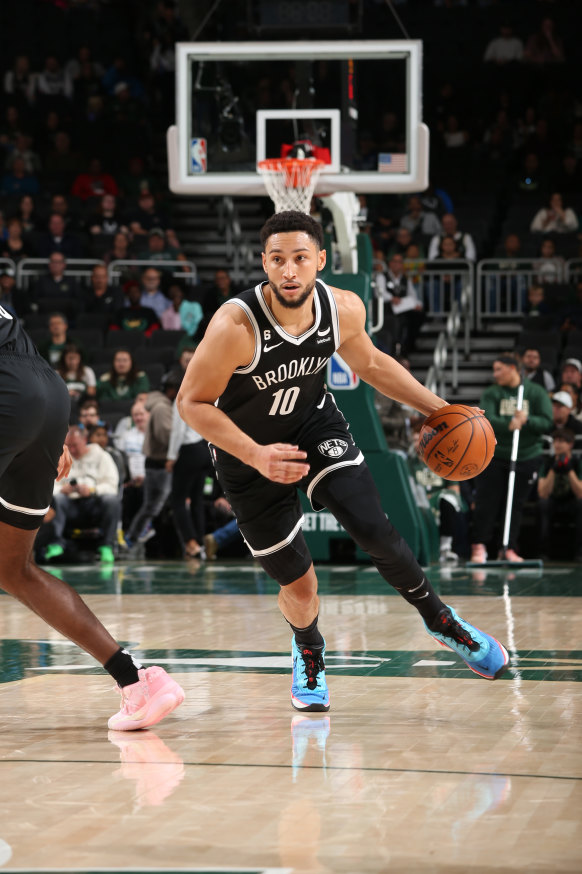
Simmons playing for the Brooklyn Nets in October this year, after recovering from a back injury.Credit: Getty Images
In February 2022 Simmons was finally traded to the Brooklyn Nets, to be part of a hoped-for “super team”. He immediately called his mum. “He literally broke down over the phone – ‘Mum, I’m going to Brooklyn’ – and I could hear it in his voice,” she says. “I could hear him take a breath. I could tell he was having a moment. I said, ‘Ben, put it all behind you, honey,’ but, of course, nothing gets put behind you.”
A back injury came next. Living in New York, he went to run upstairs one day and felt two of the lowest vertebrae in his spine – the L4 and L5 – give way. The pain was immediate. “My whole right side just dropped. I lay down in bed and couldn’t move. Nerve pain all down my leg into my calf. I had a dead foot, dragging my right, which was numb.”
The injury was met with derision, and accusations of faking – until a diagnosis in late March confirmed the injuries. Simmons is philosophical about such distrust. “Maybe people don’t know me because I don’t show them my life?” he wonders. “There are going to be haters anyway – I’m not going to try to prove anything to them. If you don’t believe me, you don’t believe me – that’s on you. It shouldn’t be up to me to convince you otherwise.”
He gathered strength slowly, until he was close to playing in a crucial final against the Boston Celtics in April. “I was supposed to play,” he confirms. “And the day before the game we’re playing 5 on 5 and 4 on 4, and I’m like, ‘Let me play one more game,’ because it just wasn’t right. I wasn’t moving the way I move. I felt something in my back, it locked up quickly. I woke up the next day – which is what tells you how you really feel – and I couldn’t move. There was no way.”
A storyline congealed – Simmons chickens out, deserts team – and he was publicly pulverised. NBA legend Reggie Miller told him to “#ManUp”, and Shaq agreed: “In the hood, we called this a punk move.” ESPN analyst Stephen A. Smith ranted that Simmons was the most selfish player in the league: “Nobody is worse than Ben Simmons! Ben Simmons might also be the weakest, most pathetic excuse for a professional athlete we have ever seen in not just American history but the history of sport,” he roared. “He’s a disgrace.”
A spine specialist thought otherwise, seeing the need for immediate surgery, showing Simmons an image of liquid being squeezed out of his herniated disc onto the nerve. He went under the knife in Los Angeles in May, walked out of surgery feeling immediate relief. “No pain,” he recalls. “I could feel my foot again. I could feel my glute trying to activate.”
Recovery and rehabilitation involved everything from a breathing machine to gruelling core exercises like 15-minute bridges. “I knew I needed to bust my ass,” he says, “because if I’m slacking I’m not going to be where I want to be, and everyone that’s talking shit now can be like, ‘Yeah, see, we were right.’ ”
But the missed final in April followed him all the way to August, when rumours emerged that teammates had messaged Simmons in a WhatsApp group saying they needed him to play that game, and that Simmons left the group, ghosting his peers. “Let me show you that,” he says, opening his phone and presenting for inspection the chat that he was supposed to have quit. “Look, nothing there. People had been leaving the group for a month. No one was even talking in it anyway. That’s just part of the bullshit.”
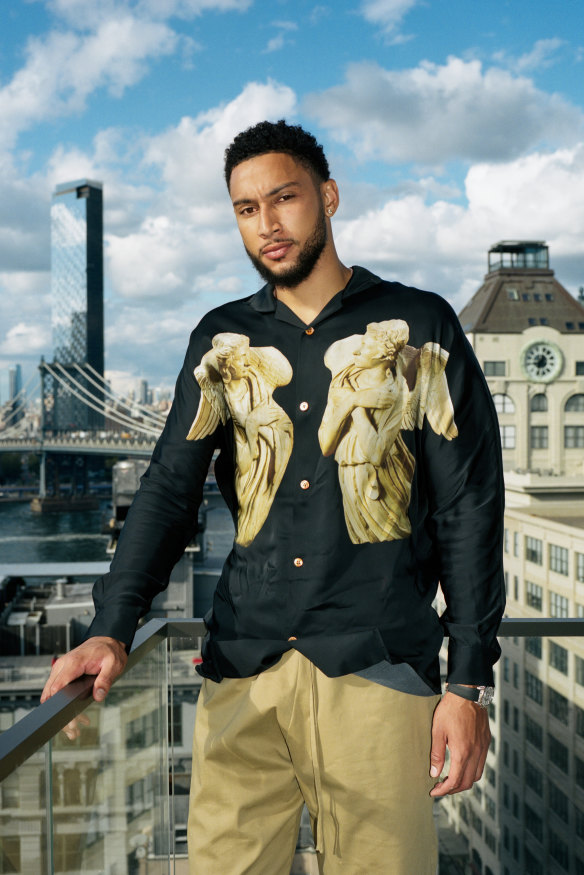
Simmons has faced criticism from fans about his time off the court. “There are going to be haters anyway – I’m not going to try to prove anything to them.”Credit: Ben Sklar
Simmons began feeling like himself only recently, finally hitting his top court speed (31 kilometres per hour) and finding his vision within the shifting geometry of the floor. The season began a fortnight ago, and his start has been shaky, yet he insists he’s figuring out how best to buttress the talent of Nets superstars Kevin Durant and Kyrie Irving, while enjoying locker-room camaraderie with fellow Aussie Patty Mills.
“Patty knows how I operate. We speak the same language,” Simmons says. “He’s helped me build mental practices: ‘What do you do when you’re feeling great?’ or ‘When you’re not feeling great, what actions do you take?’ I had isolated myself for a year. I wasn’t on social media. I wanted to have peace and be by myself and reset, because I needed it. But I stuck with therapy, too, because I think everyone should have that outlet.”
He’s doing the work. Nets fans, however, are probably more interested in him working on his jump shot and free throws. Walking through Brooklyn to a preseason game, coach Steve Nash confirms that Simmons is doing exactly that – with a rider. “What makes Ben special is his ability to play-make for others – defending, rebounding, transition. Ben can do a lot of the dirty work – deflections, steals, pushing the pace.”
Nash – who by the time of publication was sacked by the Nets, only a fortnight into an inconsistent season – basically summarises everything everyone has ever said about Simmons: he does things that gargantuan bodies aren’t supposed to do. “It’s my job to give him a platform to show that versatility,” Nash says. “Ben never has to take a shot for the Nets.”
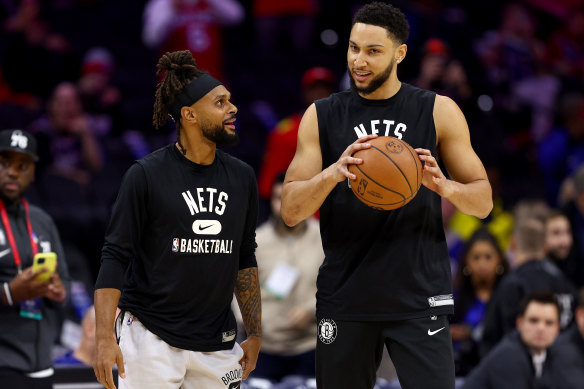
Simmons with fellow Australian and teammate Patty Mills, who has helped him through tough times. Credit: Getty Images
All he need do – apparently – is get to the basket, and the free-throw line. And when he reaches that “charity stripe” – where Nash himself once shot with 90 per cent accuracy (and Simmons shoots at 60 per cent) – what then? “I just want him to have confidence up there, not worry about makes and misses. We have to take the risk off the table for him. It can’t be all or nothing. We need to give him that mentality: Get to the line as much as you can.”
And so Simmons is doing his extras, building muscle memory into his routine – bounce twice, spin it, shoot – while the world watches. During a recent open-air practice, the Nets squad had a shooting competition – and Simmons won. He beat the entire team. Yet that same session, he also tossed a casual shot at the ring and missed everything. An airball. Guess which moment went viral?
Such scrutiny makes it hard not to ask what will happen this season if those early buckets don’t fall – if he throws more bricks than swishes. Or doesn’t shoot at all. “We’re looked at as superheroes, which is fine, but there comes a point where …” His voice trails off. “Not everybody deals with the same pressures, and not everyone deals with pressure in the same way. People are going to go through things in life, whether they say something out loud or not. I guess I don’t mind saying out loud: ‘I’ve been through things.’ ”
Ben Simmons can’t see it, but there’s a grey and red bug trudging grimly up his abdomen, like a sherpa on K-12. It’s a spotted lanternfly, an invasive pest that New Yorkers are urged to squish on sight, and it’s seeking sanctuary inside a bedazzled hole in his designer T-shirt. “Oh, shit!” Simmons says, flicking it onto the balcony of his new apartment, and crushing it under his size-14s.
Simmons currently rents in Tribeca, but right now we’re touring his newly purchased crib in the Dumbo neighbourhood of Brooklyn, a 10-minute drive from Barclays Centre, where he trains and plays. The eight-bedroom space is a construction site, so he’s holding (not wearing) a white hard hat, and the floors are covered in cardboard to stop workers scuffing the surface. Simmons prefaces an array of questions for the project manager with the word “question”, as in “Question: Has this floor sold out – will I like my neighbours?” and “Question: What about speakers and stuff?”
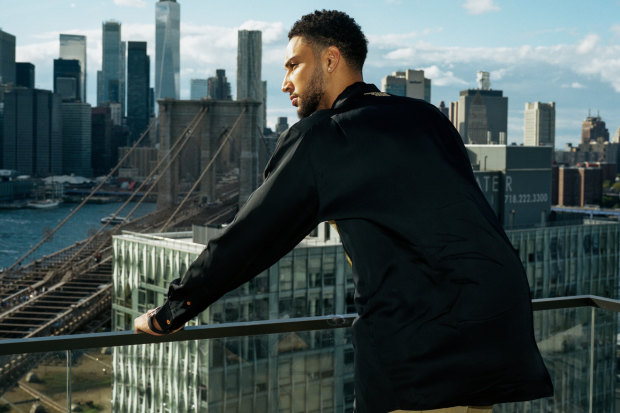
Simmons on the balcony of his new eight-bedroom apartment in Brooklyn. Credit: Ben Sklar
The reported asking price was $US13 million – not an insignificant piece of real estate alongside his $US17.5 million mansion in Los Angeles. But Simmons doesn’t want to talk about money. Fair enough. Consumption invites criticism. While injured this year, people joked that he was probably out driving – a reference to his car collection. He rolls up today in a rare Porsche 918 Spyder, but could just as easily have driven his Mercedes-Benz G Wagon or electric Hummer. He drives everywhere. A Chevy Suburban drives with him, too, a security team there both to protect him and to park his $2 million ride. “Some people think you don’t need security, like it’s a look or something, but I never want to feel like I’m in a situation where I could have had security there and didn’t.” The starting price for the 5740 Patek Philippe watch he’s wearing, after all, is about $200,000. “People are robbing people for a lot less.”
We speak during September’s New York Fashion Week, and Simmons was all over it. He especially loved the runway show for Marni, a high-end street label gravitating towards unisex pieces. “But I’m not wearing dresses,” he says, smiling. “I’m not Harry Styles.” He sets tongues wagging anyway. After posing in everything from Dior knitwear to a green lambskin leather jacket and matching shorts from Prada, one publication called him a “style icon”, but that was the exception. The standard critique? “Green one day, orange the next, got on pink shades, looking like Zoolander!” (How dare he?) The clothes, cars and exotic pets (including a piranha) feed a central perception that Simmons is a pay-cheque player, here for the limelight and spoils. “What am I supposed to do?” he responds, palms up. “Not collect the cheque? Not spend the cheque?”
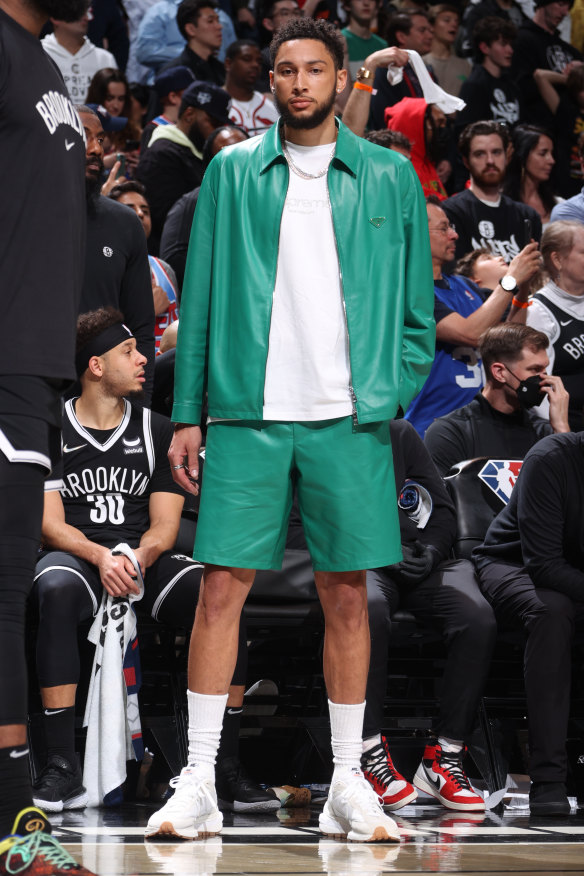
Courtside in matching Prada jacket and shorts. Simmons has been called a “style icon” as well as “looking like Zoolander”.Credit: Getty Images
The clothes most important to him are the ones he gives away. Simmons’ eldest sister, Melissa, runs his community and social-impact work (Ben Simmons Family Foundation), which includes everything from youth leadership programs to partnerships with organisations like Operation Warm (giving winter coats to kids who need them). Last year, he was forced to continue the latter anonymously. “We were a little bit worried that people in Philly might not wear the coat if they knew it was from Ben Simmons,” Melissa admits, noting that a few kids even dropped technology scholarships because his name was attached. “That was heart-wrenching.”
Still, Simmons lends his dollars and name to an array of substantive social justice programs. He was an executive producer on the 2019 Adam Goodes documentary The Australian Dream – “It’s not always easy to have somebody’s back – I wanted to have Adam’s back.” And there is his #DoMore project, which harnessed high-profile Australians, including soccer star Samantha Kerr and actor Hugh Jackman, to have conversations about racism during the global Black Lives Matter movement.
“I’m by no means an NBA expert, but you get a sense of the noise around Ben,” says diversity and inclusion campaigner Rana Hussain, who worked with Simmons on #DoMore. “He wanted to channel that exorbitant attention he gets into something useful. How mature is that?”
Then there’s his annual basketball camps, working with groups like Helping Hoops Future to open up spots for public housing kids. Julie Simmons remembers a father approaching her at one camp. His son had done a project book about the NBA: could he show it to Ben? She took the boy to the break room to see Simmons, who flipped through the pages enthusiastically. When he learnt the boy’s favourite player was LeBron James, Simmons started idly scrolling on his phone, and within seconds had LeBron on screen, FaceTiming the star-struck boy. “For me, that’s everything,” Simmons says. “There’s no better feeling than seeing a kid smile, giving them a place to have an outlet and express themselves.”
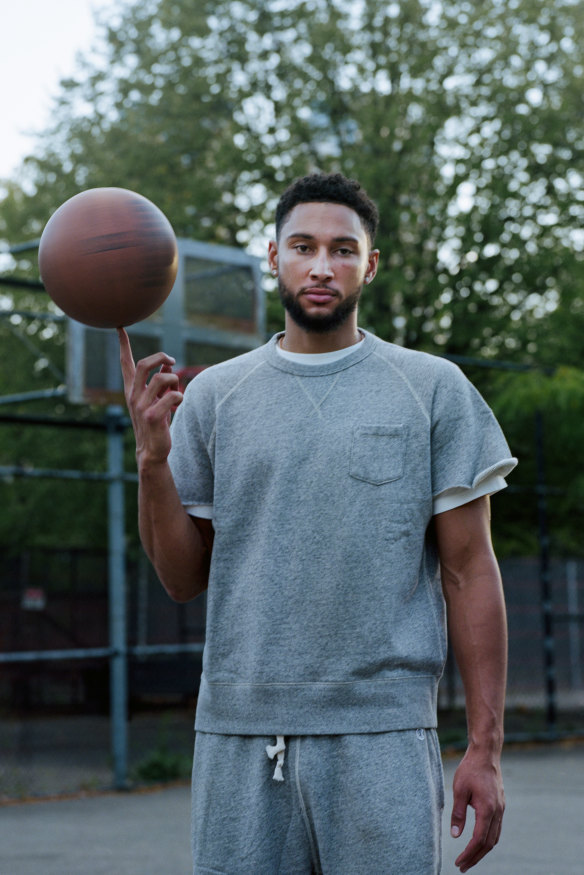
Simmons says he’s finally getting back into his groove on the court. Credit: Ben Sklar
A final critique of Simmons, of course, is that he hasn’t suited up for the Boomers since joining the NBA. The 2016 Rio Olympics fell during his rookie season, and while he wanted to play in Tokyo 2020, that was the moment his life entered freefall. “I was in the middle of the shit,” he says. “Of course I wanted to go out there and play with Dante Exum and Joe Ingles and Patty Mills – those are my guys. But there’s only so much to say: I was in a bad place, and I didn’t play. Do I want to play for Australia? One hundred per cent. Will I one day? One hundred per cent. I’m going to the Olympics. It’s not a question – it’s a dream of mine. But I’m also not going to let people tell me when and how I do things.” Paris 2024? He’s there.
At 26, Simmons is entering his sporting prime. He can picture himself by mid-season, running the floor in big games against big opponents, doing what he’s supposed to do. “You’re in your happy place. You feel good. You feel right. You feel present in the moment,” he says, sipping that soda water, above the city streets. “For two years I feel like I lost that, and was going through the motions. But right now, I feel incredible. It’s almost like heaven.”
Of course, that was two weeks before the new season began. His performances since then have been erratic, and quiet. Just this week he missed two games with knee soreness. Another setback. Maybe that’s why he also urged patience (“It won’t happen overnight”) and maybe what looked like defiant confidence (“I do things not many people can do”) was something more like positive self-talk. He doesn’t need bravado right now. He needs belief.
His challenge becomes setting new expectations instead of living up to the old ones. Like that famous marketing slogan, developed by a branding consultant around the time he was about to enter the league: Ben Simmons is next. The next LeBron. The next big thing. The next basketball story. It begs a new question: Ben Simmons … What next?
“It’s all about the win,” he answers. “Everything changes once you start winning, and then those people with things to say suddenly have nothing left to say. It’s that easy and that hard.”
To read more from Good Weekend magazine, visit our page at The Sydney Morning Herald, The Age and Brisbane Times.